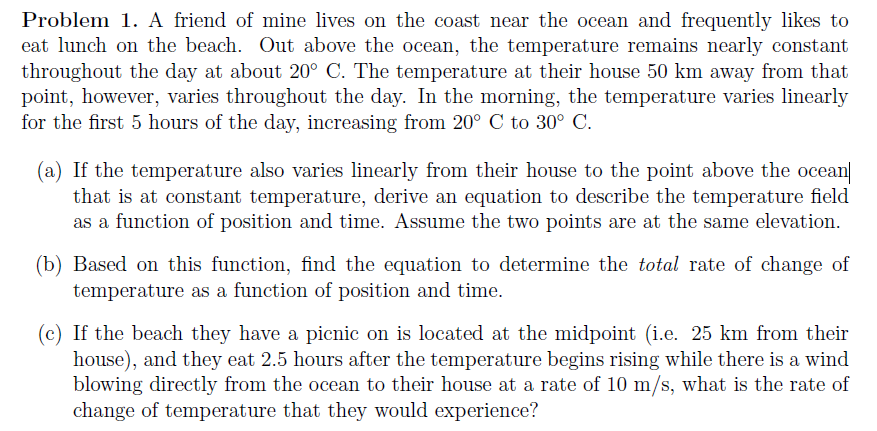Problem 1. A friend of mine lives on the coast near the ocean and frequently likes to eat lunch on the beach. Out above the ocean, the temperature remains nearly constant throughout the day at about 20° C. The temperature at their house 50 km away from that point, however, varies throughout the day. In the morning, the temperature varies linearly for the first 5 hours of the day, increasing from 20° C to 30° C. (a) If the temperature also varies linearly from their house to the point above the ocean that is at constant temperature, derive an equation to describe the temperature field as a function of position and time. Assume the two points are at the same elevation. (b) Based on this function, find the equation to determine the total rate of change of temperature as a function of position and time. (c) If the beach they have a picnic on is located at the midpoint (i.e. 25 km from their house), and they eat 2.5 hours after the temperature begins rising while there is a wind blowing directly from the ocean to their house at a rate of 10 m/s, what is the rate of change of temperature that they would experience?
Problem 1. A friend of mine lives on the coast near the ocean and frequently likes to eat lunch on the beach. Out above the ocean, the temperature remains nearly constant throughout the day at about 20° C. The temperature at their house 50 km away from that point, however, varies throughout the day. In the morning, the temperature varies linearly for the first 5 hours of the day, increasing from 20° C to 30° C. (a) If the temperature also varies linearly from their house to the point above the ocean that is at constant temperature, derive an equation to describe the temperature field as a function of position and time. Assume the two points are at the same elevation. (b) Based on this function, find the equation to determine the total rate of change of temperature as a function of position and time. (c) If the beach they have a picnic on is located at the midpoint (i.e. 25 km from their house), and they eat 2.5 hours after the temperature begins rising while there is a wind blowing directly from the ocean to their house at a rate of 10 m/s, what is the rate of change of temperature that they would experience?
Principles of Heat Transfer (Activate Learning with these NEW titles from Engineering!)
8th Edition
ISBN:9781305387102
Author:Kreith, Frank; Manglik, Raj M.
Publisher:Kreith, Frank; Manglik, Raj M.
Chapter6: Forced Convection Over Exterior Surfaces
Section: Chapter Questions
Problem 6.8P
Related questions
Question
Fluid

Transcribed Image Text:Problem 1. A friend of mine lives on the coast near the ocean and frequently likes to
eat lunch on the beach. Out above the ocean, the temperature remains nearly constant
throughout the day at about 20° C. The temperature at their house 50 km away from that
point, however, varies throughout the day. In the morning, the temperature varies linearly
for the first 5 hours of the day, increasing from 20° C to 30° C.
(a) If the temperature also varies linearly from their house to the point above the ocean
that is at constant temperature, derive an equation to describe the temperature field
as a function of position and time. Assume the two points are at the same elevation.
(b) Based on this function, find the equation to determine the total rate of change of
temperature as a function of position and time.
(c) If the beach they have a picnic on is located at the midpoint (i.e. 25 km from their
house), and they eat 2.5 hours after the temperature begins rising while there is a wind
blowing directly from the ocean to their house at a rate of 10 m/s, what is the rate of
change of temperature that they would experience?
Expert Solution
This question has been solved!
Explore an expertly crafted, step-by-step solution for a thorough understanding of key concepts.
This is a popular solution!
Trending now
This is a popular solution!
Step by step
Solved in 4 steps with 4 images

Knowledge Booster
Learn more about
Need a deep-dive on the concept behind this application? Look no further. Learn more about this topic, mechanical-engineering and related others by exploring similar questions and additional content below.Recommended textbooks for you

Principles of Heat Transfer (Activate Learning wi…
Mechanical Engineering
ISBN:
9781305387102
Author:
Kreith, Frank; Manglik, Raj M.
Publisher:
Cengage Learning

Principles of Heat Transfer (Activate Learning wi…
Mechanical Engineering
ISBN:
9781305387102
Author:
Kreith, Frank; Manglik, Raj M.
Publisher:
Cengage Learning